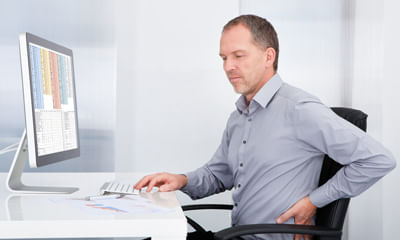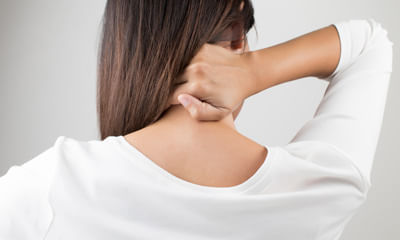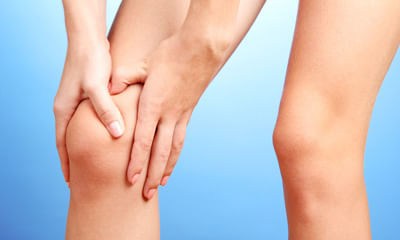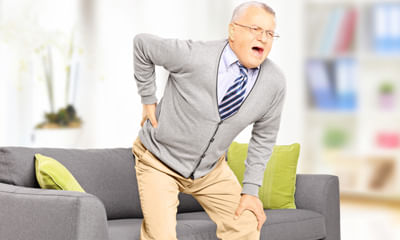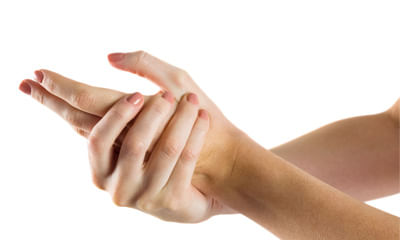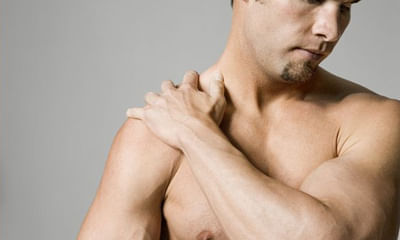Intense Left Arm Pain
Mere papa ko back pain ho rha hai acidity ya kuch aur nhi pata ek baar doctor se consult karke laye the acid problem keh ...
Ask Free Question
Back pain exercises; kindly do these exercises. Back pain is described as acute or chronic based on how long you’ve had it. Acute pain lasts days to weeks, subacute pain lasts six weeks to three months, and chronic pain lasts longer than three months. Things that make it better or worse back pain may get worse with movement or if you sit or stand for a long time. It may get better if you switch positions or walk around. Other symptoms you may experience with back pain include: •the painful spot looking swollen and feeling tender to the touch •a muscle spasm in the painful area •numbness or weakness in one or both of your legs (if the pain is due to a nerve issue) if you find you have back pain and can’t hold your urine or bowel movements, something is pressing on your spinal nerves, and you should be evaluated immediately. This condition, called cauda equina syndrome, can cause severe long-term damage to your spinal nerves if not treated right away. 6 imbalances that cause pain—and how to fix them "pain is a medical condition and a medical issue, says brett jones, owner of applied strength in pittsburgh who is certified for the functional movement screen, a system of tests and cor rective exercise strategies. "it's a warning sign. The pain is there to tell you something's wrong. And that warning sign could be more serious than "you're going too hard. Jones and the other coaches consulted for this piece all had a horror story to tell-when pain in a client meant a more serious condition such as a nerve issue, thyroid issue, or even cancer. The point: if you experience regular pain while exercising-or when you're not-go to the doctor. If you've been cleared by a doc and you're still feeling discomfort, try these simple tests to see what's truly causing the pain-it could be related to an imbalance in a completely different part of your body. The good news: with these drills, stretches, and corrective exercises, you may be able to fix them-no doctors necessary. 1. Standing extension how it helps – this standing extension helps reverse what you do on a daily basis (hunching)… since most bulging discs and herniated discs are caused by poor posture and repeated flexion of the spine (esp bending fwd in bad posture), this stretch helps push the disc back to neutral position. How to do it – begin this exercise by standing up with good posture. Now take both hands and place them on both sides of your lower back. Now with the help of your hands push your pelvis forward and extend your spine back. Follow the extension with your neck so that you end up facing the ceiling. – start with 10 repetitions and do 2-3 sets. – this one is particularly great to do when you need a break from sitting at your desk. ** this should not cause any pain. If you feel pain during it is not a good one for you. In that case, stop and try some of the other exercises below instead. 2. Half cobra pose (prone lumbar extension) how it helps – the half cobra stretch helps to push the disc material back towards the center of the inter-vertebral disc to allow for improved healing. The goal of repeated lower back extension is the “centralization of symptoms”, which basically means pain that travels down the affected leg to the foot should come back up closer to the low back – which will in turn alleviate the pain. How to do it – begin this exercise by lying on your stomach (prone position) and slowly prop yourself up on your elbows while keeping your hips in contact with the floor. – hold the prop-up position for 10-15 seconds before returning to the prone position (lying face down). – gradually increase to holding the end position for 30 seconds. Aim for 10 repetitions of this stretch. ** initially, you may not be able to tolerate this position very well, so make sure you start slowly and carefully. If there’s any pain, try a different exercise instead. 3. Full cobra pose (advanced extension) how it helps – this stretch is based on the same principle as the half cobra pose above. This advanced extension helps to push disc material back towards the center of the intervertebral disc, with the goal of alleviating pain symptoms. How to do it – once you’ve mastered the half cobra pose, you can increase the difficulty by moving to the advanced version of this stretch. Begin this exercise by lying on your stomach in the prone position (lying facing down) and slowly press up on your hands while keeping your pelvis in contact with the floor and lower back relaxed. – hold the prop-up position for 10 seconds. Aim for 10 repetitions of this stretch. – eventually try to hold this pose for longer if it feels good (20-30 seconds). ** if you feel pain during this exercise, it is not a good one for you. In that case, stop and try some of the other exercises instead. 4. Cat-cow how it helps – this is one of the most popular herniated disc exercises. By combining two yoga poses, the cat-cow stretch can help to relieve pressure on the herniated disc by opening the intervertebral disc space. It also improves mobility of the spine, which may help to relieve disc herniation pain and speed recovery. How to do it – begin this stretch on your hands and knees. Inhale and let your stomach “drop” towards the floor as you look up towards the ceiling. – follow this by exhaling and slowly rounding your spine while pressing into the floor with your hands and slightly curving your neck to look at your feet. – aim for 10 repetitions of this stretch and do 2-3 sets. How it helps – this exercise will help strengthen and stabilize your lower back and deep spine muscles. This will help you to maintain a good posture and avoid future episodes of herniated discs. How to do it: – begin on your hands and knees with your hands positioned under your shoulders and knees positioned under your hips. – raise your left arm and reach it forwards until it is aligned with your torso; at the same time, kick your right leg backwards until is it aligned with your torso. – hold this position for 2-3 seconds before slowly returning to the starting position. – repeat with your right arm and left leg. – alternate sides for 10 repetitions and do 2-3 sets. ** ensure that your head, neck, and back maintain a neutral alignment to minimize stress on your neck. 5.plank: how it helps – just like the bird dog, this “core” exercise will help bring your pelvis into right position by strengthening the deep spinal muscles and glutes (butt muscles). How to do it – begin lying on your stomach with your forearms against the mat. – engage your core and lift your body so that you are resting on your forearms and toes. – start with 10 second holds and work up to 30 second holds, do 2-3 sets. ** ensure to keep your back straight throughout the entire exercise – spine in neutral position. Thoracic expansion if you’re using a chair, sit facing forward and allow your upper body to fall over the back of the chair. Extend your arms above your head for a deeper stretch. Hold either position for 10 seconds. 1. Plank the world record for the longest plank is 8 hours. Luckily, you don’t need to hold it that long for the exercise to have an effect! in fact. You can hold it for 10-15 seconds. • the plank is similar to a push-up position, but instead of resting on your hands, you rest on your elbows and bring them directly underneath your chest. • after kneeling, lean forward and place your elbows on the ground directly below your shoulders. • lift your knees off of the floor and push your feet back. Ensure your back is straight and keep your neck aligned with the rest of your spine. • hold the position and tighten your core muscles for the desired time. 2. Side plank just like the original plank, but only balancing on one side. • lie on the floor on your side, facing sideways with your feet together. • lift up your body until you are supporting yourself with your elbow, directly below your shoulder. • raise your hips until your body is in a straight line and tighten your core muscles; your body should create a slant from your shoulders to your feet. • hold this position without dropping your hips. • repeat on the opposite side. 3. Pelvic tilt with exercise ball sit on a ball that allows your legs to be at a 90-degree angle with your feet flat on the floor. • keep your shoulders back and spine straight. • tilt your hips forward and flex your abdominals tight. • tilt your hips backward as you stick your tailbone out. • move back and forth slowly, keeping your shoulders back. • repeat 10 times for 3 sets. 4. Superman lie on your stomach, face down, with your arms out in front of you. • lift arms, legs, and chest off the floor simultaneously while keeping your hips grounded. • hold for a minimum of two seconds. • lower back down slowly. • repeat 10 times for 3 sets. 6. Crunches lie flat on your back, placing your feet flat on the floor with your legs bent. • fold your arms across your chest and lift your torso up until your head, neck, and torso are off the ground. • hold for a moment before lowering back down. • repeat. 6. Quadruped arm opposite leg raises • kneel on the floor, lean forward, and place your hands palm-down on the floor. • make sure your back is straight, your knees are below your hips, and that your palms are directly below your shoulders. • raise one arm as you raise the opposite leg until both are aligned straight out from your body, parallel to your spine.
I always get pain on my ribs and stomach and my upper back, what do you think I can do. ...
Ask Free Question
Since when r you having this?What r other symptoms that you r experiencing? By doing what like walking, exertion, eating or empty stomach- it increases or decreases in intensity. For how much time it remains? Is there stiffness also? How is your appetite?R you constipated or having loose stools? Any problem in urine?I need details of the case. In the meanwhile follow this1. Take your breakfast every day. Don't skip it. U should eat whatever your mother or grandparent eat in bfast. I mean to say whatever is your traditional food. If punjabi eat paratha, if belongs to south then take idli/ dosa etc. 2. Don't overeat 3. Don't take tea empty stomach. Eat something like a banana (if you are not diabetic) or any seasonal fruit or soaked almonds and a glass of plain water first thing in the morning (preferably within 10 mins of waking up). No only biscuits or rusk will not do. 4. Have light meals every 2 hours (in addition to your breakfast, lunch n dinner) e.g. Nariyal paani, chaach, a handful of mixed dry fruits, a handful of peanuts, any fresh n seasonal fruit (eat whole fruit not juice), a cup of curd/milk etc 5. Take simple food like rice n dal in dinner. Finish your dinner at least 2 hours before going to sleep. 6. Maintain active life style7. Avoid fast foods, spicy n fried foods, carbonated beverages 8. Take a lot of green vegetables n fruit. 9. Drink lot of water.10. Everyday preferably sleep on same time 11. Take 1tsp of ghee in bfast, lunch n dinner.
I was diagnosed with pcs (pelvic congestion syndrome) in 2021 after I went there for right flank pain along with right l ...
Ask Free Question
Better take homeopathic medicines for your condition. The other symptoms are of the disease itself. But you should take medicine regularly apart from this do morning exercise and yoga daily avoid non veg items.
For a long time I have had extreme pain in my muscles, starting from the joints. I have pain between two intervertebral ...
Ask Free Question
Follow these herbal combinations for complete cure ras raj ras 1 tablet twice a day vatari awleh 10 gm twice a day send your reports.
My left side severe pain and upper back pain during 7 months but recently this pain hurts heavily I consult doctor ne to ...
Ask Free Question
Since when r you having this?What r other symptoms that you r experiencing? By doing what like walking, exertion, eating or empty stomach- it increases or decreases in intensity. For how much time it remains? Is there stiffness also? How is your appetite?R you constipated or having loose stools? Any problem in urine?I need details of the case. In the meanwhile follow this1. Take your breakfast every day. Don't skip it. U should eat whatever your mother or grandparent eat in bfast. I mean to say whatever is your traditional food. If punjabi eat paratha, if belongs to south then take idli/ dosa etc. 2. Don't overeat 3. Don't take tea empty stomach. Eat something like a banana (if you are not diabetic) or any seasonal fruit or soaked almonds and a glass of plain water first thing in the morning (preferably within 10 mins of waking up). No only biscuits or rusk will not do. 4. Have light meals every 2 hours (in addition to your breakfast, lunch n dinner) e.g. Nariyal paani, chaach, a handful of mixed dry fruits, a handful of peanuts, any fresh n seasonal fruit (eat whole fruit not juice), a cup of curd/milk etc 5. Take simple food like rice n dal in dinner. Finish your dinner at least 2 hours before going to sleep. 6. Maintain active life style7. Avoid fast foods, spicy n fried foods, carbonated beverages 8. Take a lot of green vegetables n fruit. 9. Drink lot of water.10. Everyday preferably sleep on same time 11. Take 1tsp of ghee in bfast, lunch n dinner. Exercise in the form of yoga, cycling, swimming, gym etc. Or do suryanamaskar daily homeopathy is a very effective for this problem n has very encouraging results. For details, consult online.
I had pain in the rotator cuff of my left shoulder for almost a year now. My mri shows periarthritis and degeneration. D ...
Ask Free Question
Rotator cuff tear: the rotator cuff is a group of four muscles and tendons that help stabilize the shoulder. They also aid in movement. Every time you move your shoulder, you are using your rotator cuff to stabilize and help move the joint. The rotator cuff is a commonly injured area. The most common injuries are strains, tendinitis, and bursitis. Causes: rotator cuff injuries can range from mild to severe. They tend to fall into one of three categories. Tendinitis is an injury caused by overuse of the rotator cuff. This causes it to become inflamed. Tennis players, who use an overhead serve and painters who have to reach upward to do their jobs commonly experience this injury. Bursitis is another common rotator cuff injury. It’s caused by inflammation of the bursa. These are fluid-filled sacs that sit between the rotator cuff tendons and the underlying bone. Rotator cuff strains or tears are caused by overuse or acute injury. The tendons that connect muscles to bones can overstretch (strain) or tear, partially or completely. The rotator cuff can also strain or tear after a fall, a car accident, or another sudden injury. These injuries typically cause intense and immediate pain. Symptoms: not all rotator cuff injuries cause pain. Some are the result of degenerative conditions, meaning the rotator cuff could be damaged for months or years before symptoms start to appear. Common rotator cuff injury symptoms include: •avoiding certain activities because they cause pain •difficulty achieving full range of shoulder motion •difficulty sleeping on the affected shoulder •pain or tenderness when reaching overhead •pain in the shoulder, especially at night •progressive weakness of the shoulder •trouble reaching behind the back if you’ve been experiencing any of these symptoms for longer than a week or lose function in your arm, see your doctor. Risk: rotator cuff injuries can be acute or degenerative. Acute injuries usually occur from one particular incident. These can be caused by lifting objects that are too heavy, falling, or having the shoulder forced into an awkward position. Young people are more likely to experience this type of rotator cuff injury. Degenerative injuries are due to long-term overuse. People most at risk for these injuries include: •athletes, particularly tennis players, baseball players, rowers, and wrestlers •people with jobs that require repetitive lifting, such as painters and carpenters •people above 40 years of age treated: treatments range from resting the affected arm to surgery. Tendinitis can progress to a rotator cuff tear, and that injury can get worse with time. Seeking treatment as quickly as possible helps keep the injury from progressing. Nonsurgical treatments improve symptoms in about 50 percent of people with a rotator cuff injury. These kinds of treatments include: •applying hot or cold packs to the affected shoulder to reduce swelling •exercises to restore strength and range of motion •injecting the affected area with cortisone, a steroid that helps to reduce inflammation •resting the affected arm and wearing a sling to isolate arm motions •over-the-counter anti-inflammatory medications, such as ibuprofenand naproxen prevented: athletes and people with occupations that require using the shoulder should take frequent rest breaks. This can reduce the load on the shoulder. Exercises to strengthen the shoulder and encourage range of motion also can help. Ask your physical therapist for stretches and strengthening exercise to improve the function of your rotator cuff. In the case of shoulder pain, icing the affected area can help reduce swelling. Apply ice in a cloth-covered pack for no more than 10 minutes at a time. These activities can also help prevent re-injury. First aid for muscle strains:most muscle strains can be successfully treated at home. Mi nor muscle strains can be treated with rest, ice, compression, and elevation (rice). Rest avoid using your muscle for a few days, especially if movement causes an increase in pain. But too much rest can cause muscles to become weak. This can prolong the healing process. After two days, slowly begin using the affected muscle group, taking care not to overdo it. Ice apply ice immediately after injuring your muscle. This will minimize swelling. Don’t put ice directly on your skin. Use an ice pack or wrap ice in a towel. Keep the ice on your muscle for about 20 minutes. Repeat every hour on the first day. For the next several days, apply ice every four hours. Compression to reduce swelling, wrap the affected area with an elastic bandage until swelling comes down. Be careful not to wrap the area too tightly. Doing so can reduce your blood circulation. Elevation whenever possible, keep the injured muscle raised above the level of your heart.
Hi! I am ganesh. I am suffering with backache from more than one year, and I preferred clindamycin and benzoyl peroxide ...
Ask Free Question
Bridgethis pose activates your glutes to lift your hips. This trains your core while toning your butt and thighs. Start on your back. Bend your knees and plant your feet on the floor at hip width. Place your hands at your sides, palms down. Tighten your core and glutes. Raise your hips until your knees are in line with your shoulders. Hold for 10–30 seconds. Crunch crunches are a classic core-strengthening move. The act of lifting your upper body works your abdominal muscles. If you have low back pain, do crunches with care. Move slowly and start with just a few reps. Start on your back. Bend your knees and plant your feet on the floor at hip width. Line up your head and spine. Cross your arms across your chest. Tighten your core and relax your neck and shoulders. Tuck in your chin and lift your upper back, keeping your lower back, pelvis, and feet on the floor. Pause. Slowly lower your upper back to return to the starting position. Start with 1 set of 8–12 reps. Plank the plank is a full-body exercise that targets your core. It also strengthens your arms, shoulders, back, glutes, and legs. Start on all fours, with your hands below your shoulders and your knees below your hips. Straighten your legs behind you, keeping your feet hip-width apart. Tighten your core. Hold for 10–30 seconds. To make this exercise easier, place your knees on the floor. Supine toe tap the supine toe tap is a basic pilates exercise. It engages your core muscles while working your glutes, hips, and legs. Toe taps also place minimal pressure on your spine. If you have back pain, toe taps may be an ideal alternative to crunches. Start on your back. Lift your legs, knees bent to 90 degrees. Place your hands at your sides, palms down. Tighten your core. Lower your right foot and gently tap the floor, keeping your left leg still and your back flat. Raise your right leg to return to the starting position. Repeat with your left leg. Start with 1 set of 8–12 reps. Bird dog the bird dog engages both your abdominal and back muscles, so it’s an ideal core-strengthening move. It also challenges your coordination, balance, and stability.++ start on all fours, hands below your shoulders and knees below your hips. Tighten your core. Lift and straighten your right leg to hip level. Simultaneously lift and extend your left arm to shoulder level, palm down. Pause. Repeat with your left leg and right arm. Start with 1 set of 8–12 reps. Mountain climber this intermediate exercise combines a plank with knee movements, so it’s an excellent move for balance and core strength. Start in a plank with your hands below your shoulders. Tighten your core. Lift your right knee toward your chest, keeping your back straight and hips down. Return your right leg to the starting position as you simultaneously lift your left knee toward your chest. Continue alternating legs. Start with 1 set of 8–12 reps. Warrior crunch this crunch variation works your core and lower body, including your thighs, glutes, and quads. Stand with your feet slightly wider than shoulder width and your toes turned outward. Put your hands behind your head and open your chest. Tighten your core and glutes. Bend your knees until your thighs are parallel to the floor. Bend your torso to the side, moving your right elbow toward your right thigh. Repeat on the left side. Start with 1 set of 8–12 reps. Side plank with rotation this exercise is an advanced version of the basic plank. It strengthens the arms, shoulders, and obliques by combining a side plank with arm movements. Lie on your right side with your right forearm below your shoulder. Extend your legs, left foot on top of right. Tighten your core. Lift your hips to form a straight line with your body. Raise your left arm straight up. Rotate your torso toward the floor and bring your left arm under your body. Rotate your torso and straighten your left arm to return to the starting position. Start with 1 set of 8–12 reps. Repeat on the other side. Bird dog with elbow to knee this variation on the basic bird dog incorporates fluid movement to engage your abs and back while improving core mobility. Start on all fours, hands below your shoulders and knees below your hips. Tighten your core. Lift and straighten your right leg to hip level. Simultaneously lift and extend your left arm to shoulder level, palm down. Bring your right knee and left elbow toward each other. Return to the starting position. Start with 1 set of 8–12 reps. Repeat on the other side. Bicycle crunch this classic exercise strengthens your abs by placing them under constant tension. Start on your back. Bend your knees and plant your feet on the floor at hip width. Line up your head and spine. Place yours behind your head, elbows pointing out to the sides. Tighten your core and move your shoulders back and down. Bend your right knee toward your chest and extend your left leg, lifting it a few inches off the floor. Lift your left shoulder and upper back, bringing your left elbow toward your right knee. Tap your left shoulder on the floor and simultaneously switch your legs. Continue alternating elbows and knees, starting with 1 set of 8–12 reps.
My x ray showing anterior wedge at d12 vertebra. What should I do. Feeling pain left side shoulder hand leg. Kindly help ...
Ask Free Question
Frozen shoulder is the common name for adhesive capsulitis, which is a shoulder condition that limits your range of motion. When the tissues in your shoulder joint become thicker and tighter, scar tissue develops over time. As a result, your shoulder joint doesn’t have enough space to rotate properly. Common symptoms include swelling, pain, and stiffness. You’re more likely to have the condition if you’re between the ages of 40 and 60symptomsyou become aware of a frozen shoulder when it begins to hurt. The pain then causes you to limit your movement. Moving the shoulder less and less increases its stiffness. Before long, you find that you can’t move your shoulder as you once did. Reaching for an item on a high shelf becomes difficult, if not impossible. When it’s severe, you might not be able to do everyday tasks that involve shoulder movement such as dressing. Shoulder exercises and stretchesregular exercises and stretches can keep your shoulder strong and flexible. A few things to remember before swinging in to exercises: •stop any exercise if you have more shoulder pain. It may be too soon for you to try. •watch your form. Exercising incorrectly can also cause or worsen shoulder problems. •warm up, even before deep stretching. Light shoulder rolls, gentle movements, or even a warm shower are all ways to warm up your muscles before exercise and stretching. Pendulum stretch for range of motion•stand and bend at the waist. •let your arm on the injured side hang straight down. •keep your neck relaxed. •move your arm in a circle up to 20 times. •do once or more times in a day. Overhead shoulder stretch•sit or stand to do this shoulder stretch. •intertwine your fingers in front of you. •bend your elbows and raise your arms above your head. You can also place your hands on your head or behind it. •gently squeeze your shoulder blades together to move your elbows back. •continue for up to 20 repetitions. Repeat 5 to 10 times a day. Physical therapyphysical therapy is the most common treatment for a frozen shoulder. The goal is to stretch your shoulder joint and regain the lost motion. It can take anywhere from a few weeks to nine months to see progress. A home exercise program of gentle range of motion exercises is important. If you don't see progress after six months of intense, daily exercises, speak to your doctor about other options.
Hello doctor, I am 19 years old male. 1 year ago, I did some intense exercises, due to which I suffer from lower back pa ...
Ask Free Question
Back pain can affect people of any age, for different reasonsas people get older, the chance of developing lower back pain increases, due to factors such as previous occupation and degenerative disk disease. Lower back pain may be linked to the bony lumbar spine, discs between the vertebrae, ligaments around the spine and discs, spinal cord and nerves, lower back muscles, abdominal and pelvic internal organs, and the skin around the lumbar area. •acute pain starts suddenly and lasts for up to 6 weeks. •chronic or long-term pain develops over a longer period, lasts for over 3 months, and causes ongoing problems. Home advise: •resting from strenuous activity can help, but moving around will ease stiffness, reduce pain, and prevent muscles from weakening. •applying heat, ice, ultrasound, and electrical stimulation — as well as some muscle-release techniques to the back muscles and soft tissues — may help alleviate pain. •as the pain improves, the physical therapist may introduce some flexibility and strength exercises for the back and abdominal muscles. Techniques for improving posture may also help. •the patient will be encouraged to practice the techniques regularly, even after the pain has gone, to prevent back pain recurrence. Regular exercise helps build strength and control body weight. Guided, low-impact aerobic activities can boost heart health without straining or jerking the back. Before starting any exercise program, talk to a health care professional. There are two main types of exercise that people can do to reduce the risk of back pain: •core-strengthening exercises work the abdominal and back muscles, helping to strengthen muscles that protect the back. •flexibility training aims at improving core flexibility, including the spine, hips, and upper legs. We suggest you to wear lumbosacral corset (belt) which is available at our clinic. If you want you can buy from us, if you are far away from chennai we can send you by courier. The reason why we are conveying you to buy from us is we can demonstrate over the videocall (using whatsapp) and also we can monitor you throughout when to wear it and how long to wear it. And also if you find any difficulty wearing the brace you can also revert back to us for few more suggestions and we can propose you good solution how to go about it. Uses of lumbosacral corset (belt) a lumbosacral corset adds pressure to the intra-abdominal area. This adds stability to the spine. It is prescribed to people suffering from moderate to severe pain. Other benefits of using a lumbar spine belt are: 1.helps in a certain degree of immobilization of facet joints. 2.reduces pain to allow continuation of normal activities. 3.speeds up the healing process. 4.the pressure exerted by a lumbar spine belt helps in stretching the erector spine muscles. 5.this belt can also be used to support the lower back while exercising. Helps prevent rolling provides stability to lumbar and sacral regions of the back can be used when performing actions like lifting and handling heavy items can also be used when playing sports restricts back movement to aid treatment of back problems do’s and don’ts sitting do: • sit as little as possible and then only for short periods. • place a supportive towel roll at the belt line of the back especially when sitting in a car. • when getting up from sitting, keep the normal curves in your back. Move to the front of the seat and stand up by straightening your legs. Avoid bending forward at the waist. • try to keep the normal curves in your back at all times. Don’t: • do not sit on a low soft couch with a deep seat. It will force you to sit with your hips lower than your knees and will round your back. You will loose the normal curve in your back. • do not place your legs straight out in front of you while sitting (e.g. Sitting in the bath tub). Standing do: • if you must stand for a long period of time, keep one leg up on a foot stool. • adapt work heights. Don’t: • avoid half bent positions. Lifting avoid lifting if you can. Do: • use the correct lifting technique. Keep your back straight when lifting. Never stoop or bend forward. Stand close to the load, have a firm footing and wide stance. Kneel on one knee, keeping the back straight. Have a secure grip on the load and lift by straightening your knees. Do a steady lift. Shift your feet to turn and do not twist your back. Don’t: • do not jerk when you lift. • do not bend over the object you are lifting. Lying do: • sleep on a good firm surface. • if your bed sags, use slats or plywood supports between the mattress and base to firm it. You also can place the mattress on the floor, a simple but temporary solution. • you may be more comfortable at night when you use a pillow for support. Don’t: • do not sleep on your stomach unless advised to do so by your doctor or physical therapist. Bending forward do: • keep the natural curves of your back when doing these and other activities: making a bed, vacuuming, sweeping or mopping the floor, weeding the garden or raking leaves. Coughing and sneezing do: • bend backwards to increase the curve of your back while you cough or sneeze. Driving a car do: • drive the car as little as possible. It is better to be a passenger than to drive yourself. • move the seat forward to the steering wheel. Your seat must be close enough to the wheel to keep the natural curves of your back. If your hips are lower than your knees in this position, raise yourself by sitting on a pillow. Exercises for low back pain 1. Bridges •lie on the ground and bend the knees, placing the feet flat on the floor hip-width apart. •press the feet into the floor, keeping the arms by the sides. •raise the buttocks off the ground until the body forms a straight line from the shoulders to the knees. •squeeze the buttocks with the shoulders remaining on the floor. •lower the buttocks to the ground and rest for a few seconds. •repeat 15 times and then rest for 1 minute. •do 3 sets of 15 repetitions. 2.lying lateral leg lifts •lie on one side with the legs together. •keep the lower leg slightly bent. •draw the bellybutton into the spine to engage the core muscles. •raise the top leg about 18 inches, keeping it straight and extended. •hold the position for 2 seconds. •repeat 10 times. •turn onto the other side of the body and repeat, lifting the other leg. •perform 3 sets on each side. 3.supermans •lie face down on the ground and stretch both arms out in front of the body, keeping the legs stretched out and flat on the ground. •raise both the hands and feet, aiming to create a gap of about 6 inches between them and the floor. •try to pull in the bellybutton, lifting it off the floor to engage the core muscles. •keep the head straight and look at the floor to avoid neck injury. •stretch the hands and feet outward as far as possible. •hold the position for 2 seconds. •return to the starting position. •repeat 10 times. 4.partial curls •lie back on the floor and bend the knees, keeping the feet flat and hip-width apart. •cross the hands over the chest. •breathe in deeply. •on the breath out, engage the abdominal muscles by pulling in the stomach. •gently raise the head and shoulders 2 inches off the ground while keeping the neck in line with the spine. •hold for 5 seconds then return to the starting position. •repeat the exercise 10 times. •perform 3 sets. 5.knee-to-chest stretches •lie on the back on the floor. •bend the knees, keeping both feet flat on the floor. •use both hands to pull one knee in toward the chest. •hold the knee against the chest for 5 seconds, keeping the abdominals tight and pressing the spine into the floor. •return to the starting position. •repeat with the opposite leg. •repeat with each leg 2–3 times twice a day. 6.lower back rotational stretches •lie back on the floor with bent knees and feet flat on the ground. •keeping the shoulders firmly on the floor, gently roll both bent knees over to one side. •hold the position for 5–10 seconds. •return to the starting position. •gently roll the bent knees over to the opposite side, hold, and then return to the starting position. •repeat 2–3 times on each side twice a day. 7.seated lower back rotational stretches •sit on a stool or chair without arms, keeping the feet flat on the floor. •twist at the core to the right, keeping the hips square and the spine tall. •position the hands behind the head or place the left hand on the right knee to support the stretch. •hold the position for 10 seconds. •repeat the exercise on the left-hand side. •repeat on each side 3–5 times twice a day. Posture when standing: make sure you have a neutral pelvic position. Stand upright, head facing forward, back straight, and balance your weight evenly on both feet. Keep your legs straight and your head in line with your spine. Posture when sitting: a good seat for working should have good back support, arm rests and a swivel base. When sitting, try to keep your knees and hips level and keep your feet flat on the floor, or use a footstool. You should ideally be able to sit upright with support in the small of your back. If you are using a keyboard, make sure your elbows are at right-angles and that your forearms are horizontal. Shoes: flat shoes place less of a strain on the back. Driving: it is important to have proper support for your back. Make sure the wing mirrors are properly positioned so you do not need to twist. The pedals should be squarely in front of your feet. If you are on a long journey, have plenty of breaks. Get angle. Out of the car and walk around. Bed: you should have a mattress that keeps your spine straight, while at the same time supporting the weight of your shoulders and buttocks. Use a pillow, but not one that forces your neck into a steep.
I got severe pain in my left arm sometimes I also sometimes loose control on micturition and pee anywhere whenever I get ...
Ask Free Question
I am sorry to hear about your concern but will be happy to assist you. Often, an initial symptom of a heart attack is sudden left arm pain that gets increasingly intense over the course of a few minutes. Other symptoms of heart attack are: discomfort/pressure in the center of the chest. Discomfort in the jaw, neck, back, or stomach. Let's connect over a call so that we can discuss your concern in details and make a suitable treatment plan for you.

